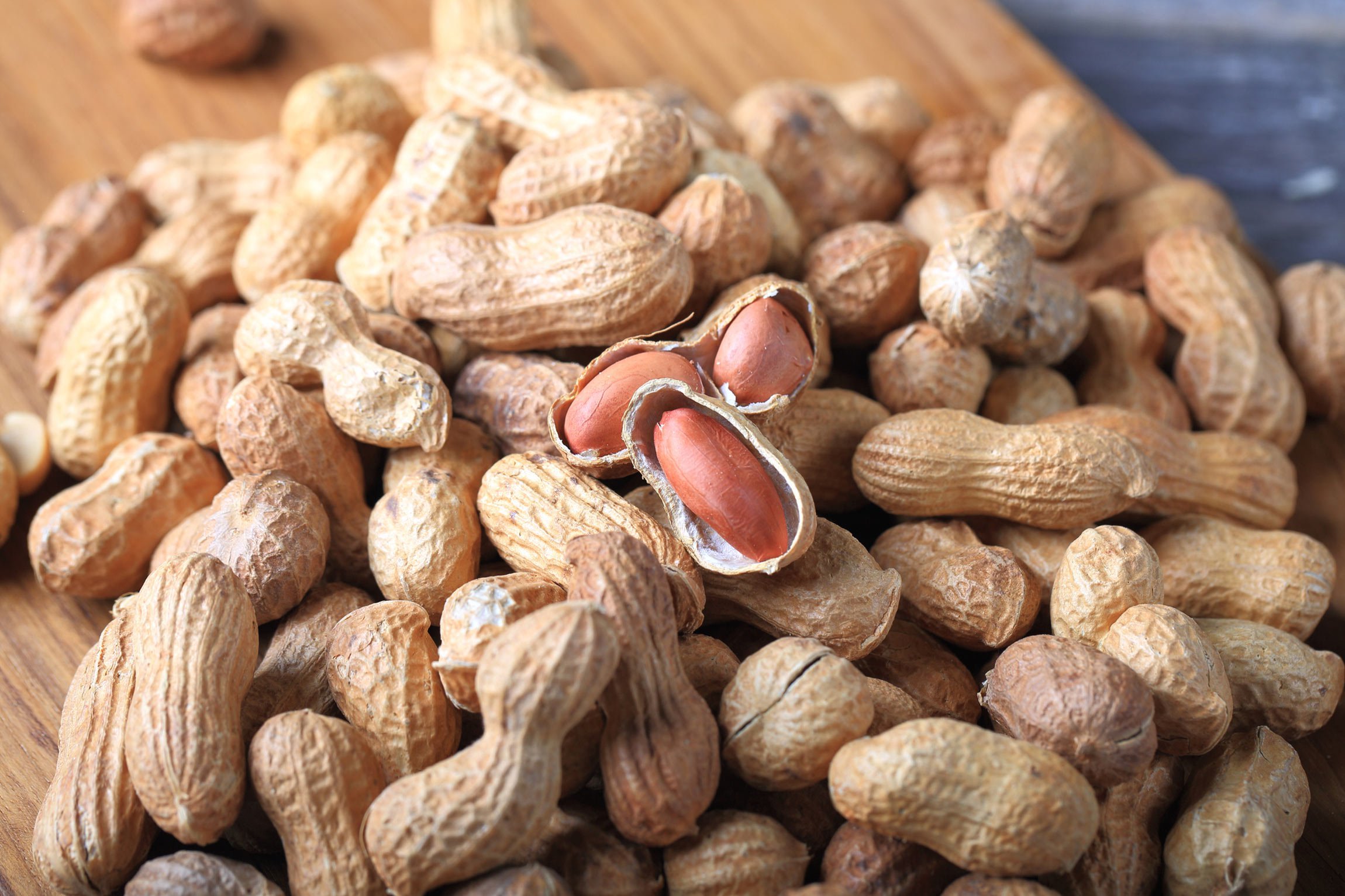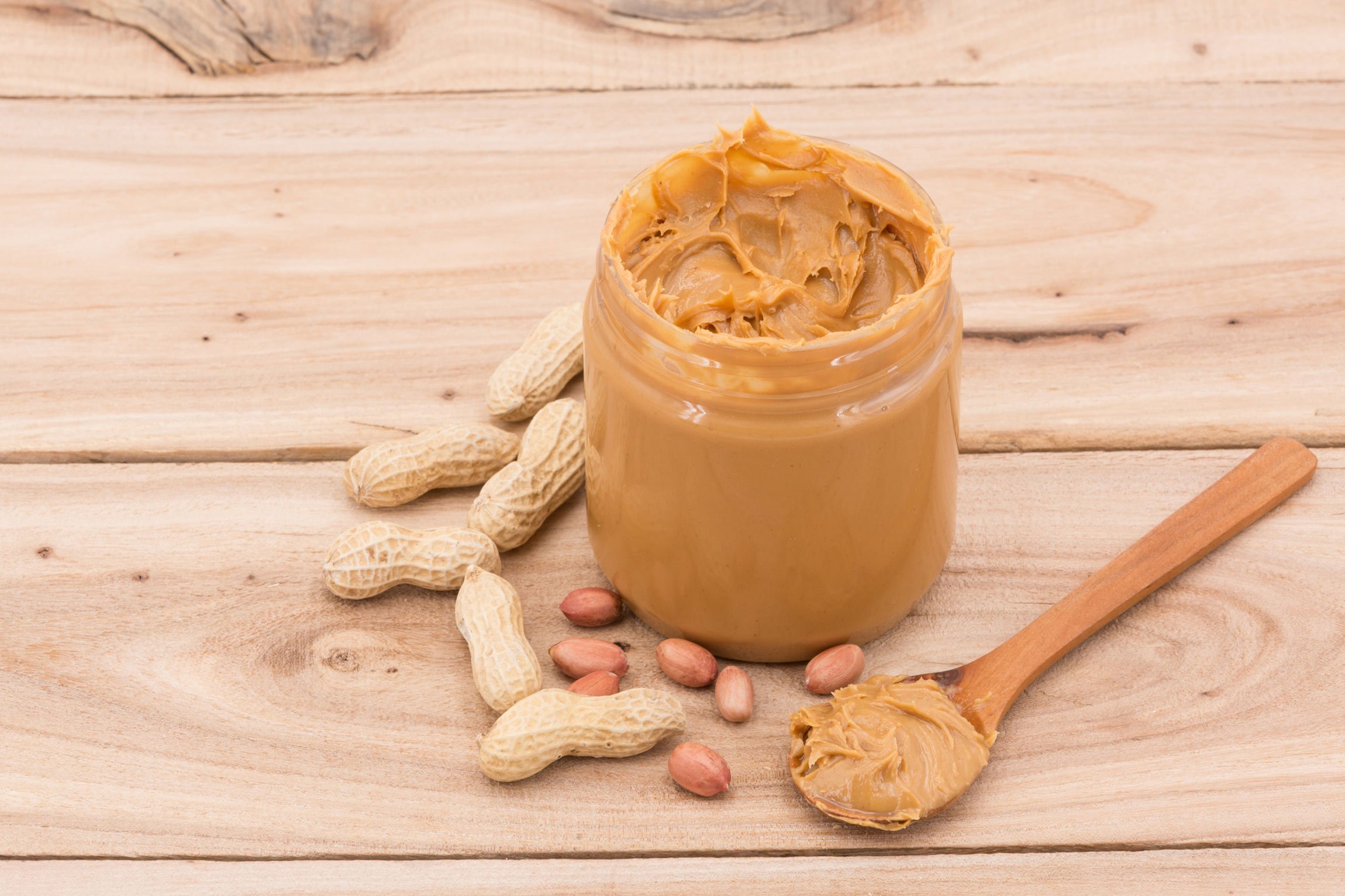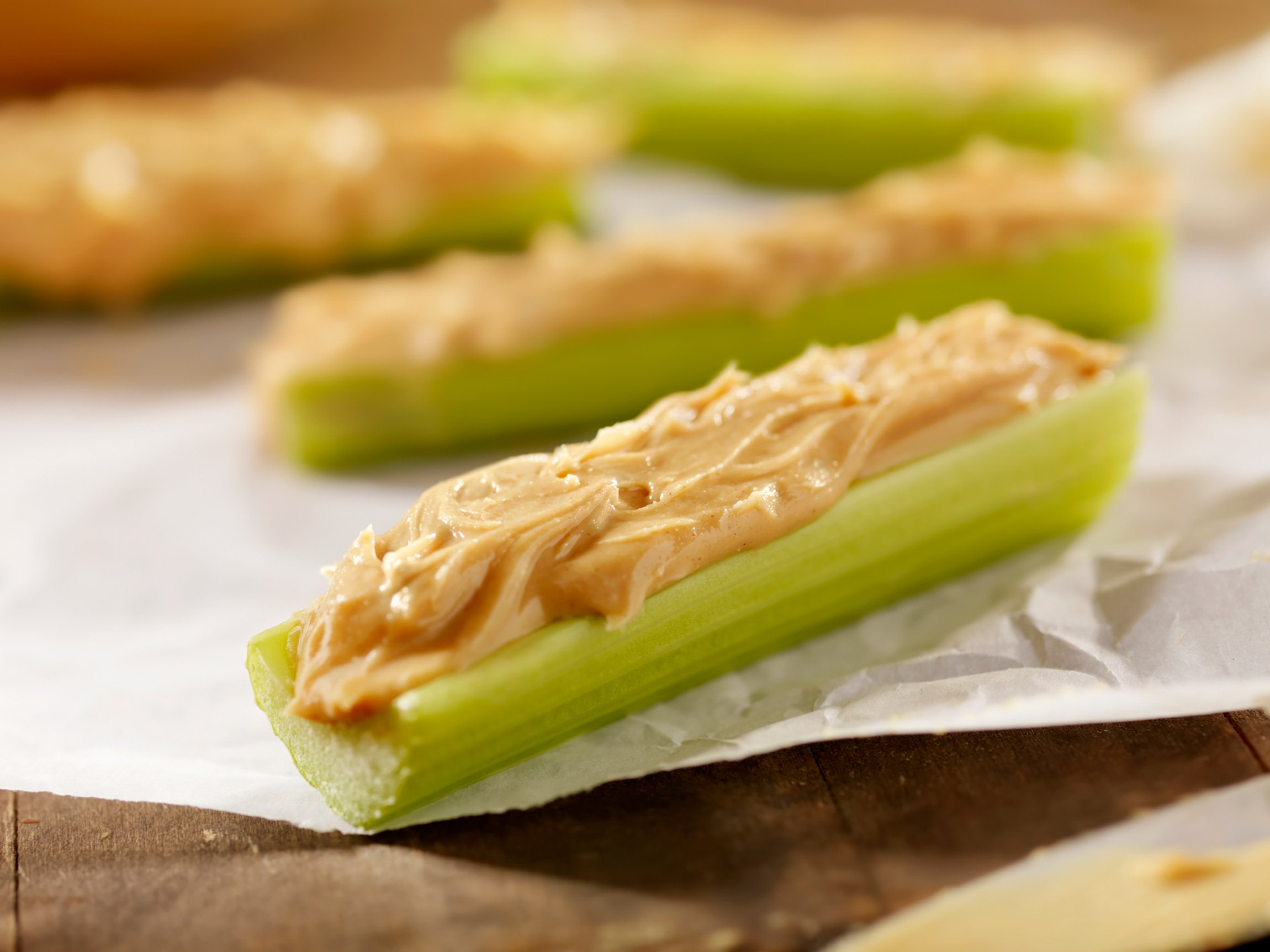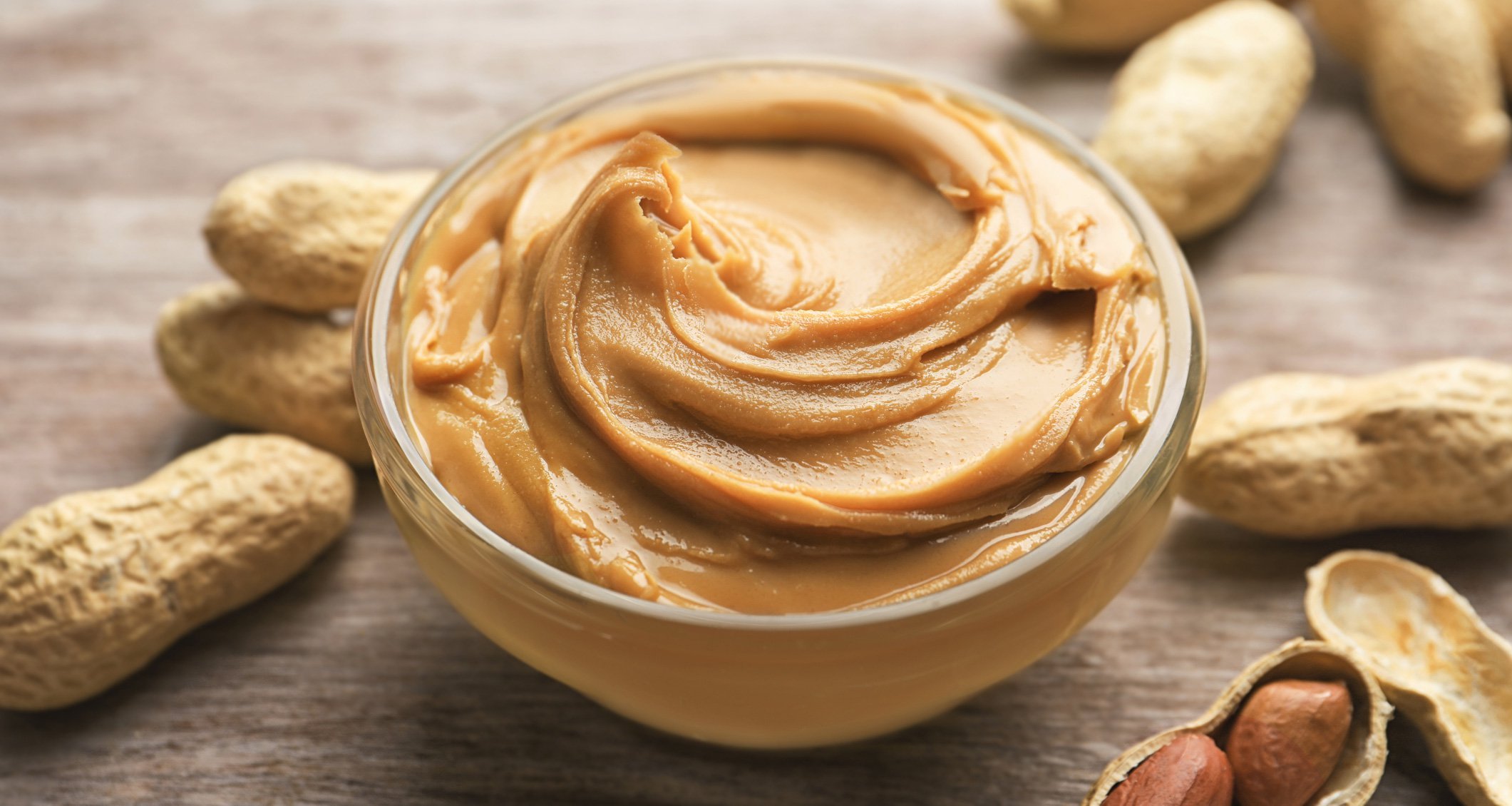Peanut butter is a favorite food in America, and it’s enjoyed in many countries around the world.
Some estimate that the average American kid eats around 1,500 PB&J sandwiches before graduating from high school. And according to the National Peanut Board, a jar of peanut butter can be found in over 90% of U.S. households. Is yours one of them?
Mine is. I love peanut butter! Whether I slather it onto a slice of whole grain bread, mix it into a curry sauce, or meld it into a warm and satisfying soup.
One of my secret late night snacks: a banana dipped in peanut butter! I also love smearing it on the inside of celery sticks. And my dad has even been known to spread it on a slice of cantaloupe!
There are endless ways to enjoy peanut butter, but that leads me to an important question. Is peanut butter good for you?
To answer this, let’s examine this cherished pantry staple.
Unless you’re in the 1% of people who have a peanut allergy or you have a severe case of arachibutyrophobia (the fear of getting peanut butter stuck to the roof of your mouth), read on.
Get to Know the Basics of Peanut Butter

Did you know that peanuts aren’t actually, botanically-speaking, nuts?
They’re legumes. Legumes are the edible seeds or pods of plants. Other legumes include beans, peas, and lentils. But from culinary and nutritional perspectives, they are indeed very much like nuts.
Grind up roasted peanuts into a paste and, voila! You’ve got peanut butter.
Who came up with the idea of mashing up peanuts, anyway? George Washington Carver, an American botanist and inventor, is often erroneously credited with inventing peanut butter. Carver did find a lot of uses for peanuts — over 300 to be exact — but he didn’t come up with peanut butter.
There’s actually evidence that, long before Carver, roasted peanuts were being ground up by the Aztecs and Incas.
The peanut butter that we know and love today emerged from the work of multiple people at the turn of the 19th century. Marcellus Gilmore Edson patented peanut paste in 1884. In 1895, Dr. John Harvey Kellogg (the fellow who more or less invented corn flakes) patented a new process for making peanut butter. He then advertised it as a protein for people without teeth.
Peanut butter continued to gain popularity over the next century, and the rest is history.
You can now find peanut butter-flavored everything, from cookies to snack bars to cereals. Peanut butter itself comes blended with many flavors now, too — chocolate, vanilla, cinnamon, maple, and I’ve even seen cookie dough.
People love peanut butter because it’s affordable, simple, and versatile. And to most people (though definitely not everyone), peanut butter is delicious. But is it also nutritious? Let’s see what it has to offer.
Peanut Butter Nutrition

It’s fair to claim peanut butter as a good source of protein. And even a small serving also contains a lot of important vitamins and minerals.
In just two tablespoons, you’ll find 8 grams of protein and 2 grams of fiber. It’s also a remarkably rich source of manganese, niacin, vitamin E, magnesium, and phosphorous.
Here are 3 Excellent Reasons to Eat Peanuts:
1) Peanuts Are a Healthy Plant Protein
The protein content of peanuts is around 22-30% of total calories. This makes peanut butter a great plant-based protein source.
Peanuts offer more protein than any actual nuts. They also contain all 20 amino acids, including arginine, which is important for heart health.
2) Peanuts Have Complex Carbohydrates and Fiber
Peanut butter contains complex carbohydrates. And it’s low on the glycemic index scale, so it won’t spike your blood sugar.
It also provides fiber, which will help you feel fuller longer. And it helps feed the beneficial bacteria in your microbiome.
3) Peanuts Are a Crucial Source of Nutrition
Peanuts are an energy-dense and nutrient-dense food. And they’re a highly filling food.
It makes sense, then, that peanuts have been used as an important source of nutrition for people on difficult expeditions to remote areas, under challenging conditions. Peanuts have helped people travel to Antarctica, fly into space, and trek all over the world. Peanuts have also played a crucial role in the elimination of malnutrition in several African countries.
Keep in mind that, as nutritious as it is, it’s easy to eat too much of this high-calorie food. Just two tablespoons contain two hundred calories, including over 15 grams of fat. If used as a staple food, peanut butter probably won’t help you lose weight.
And if you have diabetes or insulin resistance syndrome, then you may need to be vigilant with all high-fat foods, including peanuts, since there are some studies which correlate high-fat consumption with increased risk and severity of these conditions. Moderation is often key to reap the most benefits.
Is Peanut Butter Good for You? 5 Health Benefits of Peanut Butter
See all the reasons eating peanut butter can beneficial for your health:
1) Peanuts are High in Antioxidants
In fact, they have as many antioxidants as many powerful fruits, like strawberries.
Antioxidants help your body to counteract oxidative stress that can lead to chronic disease.
Peanuts contain one particularly potent antioxidant, resveratrol. Resveratrol may help reduce your risk of cardiovascular disease, Alzheimer’s disease, and cancer.
2) Peanuts Can be Good for Your Heart
A 2015 study published in the Journal of the American Medical Association looked at the impacts of nut consumption on mortality risk among just under 72,000 European and African Americans of low socioeconomic status.
They found that those individuals who ate the most nuts — especially peanuts (which they considered a “nut for the purposes of the study”) — had the lowest risk of death overall and from cardiovascular disease, in particular.
3) Peanuts Can Help Prevent Cancer
In addition to antioxidants, peanuts are great sources of vitamins, minerals, and fiber.
A 2018 study in the Nutrition Journal looked at peanut, pine nut, and almond consumption among 923 colorectal cancer patients and 1,846 controls in Korea. For both men and women, a higher intake of nuts (at least 3 servings per week) was strongly associated with a reduced risk for colorectal cancer.
Another study in 2013, published in Breast Cancer Research and Treatment, looked at peanut butter consumption and risk for breast disease in preteen girls.
The researchers followed 9,000 preteen girls for 15 years, finding that those who ate peanut butter at least three days per week had a 39% lower risk of developing benign breast disease as they got older.
4) Peanuts Can Help Keep Your Brain Healthy
Peanuts are rich in unsaturated fats, vitamin E, and B vitamins, all important for brain health.
Some studies have shown that eating nuts can help improve cognition, memory, and recall.
Other studies have found that peanuts, in particular, produce a certain brainwave associated with better sleep, improved immunity, and the natural healing ability of the body.
Peanuts are also high in niacin, a nutrient found to be beneficial in the prevention of Alzheimer’s disease.
5) Peanuts Can Help Fight Stress
Peanut butter contains a phytosterol called beta-sitosterol, which has been shown to help normalize high cortisol levels in studies of endurance athletes.
Cortisol is also known as the body’s stress hormone, so eating peanut butter may help manage feelings of anxiety.
The Controversial Components of Peanut Butter

The standard recipe for peanut butter is pretty simple: peanuts.
Yet, different brands may add other ingredients to change flavor, texture, or even alter its nutritional profile. Some of these additives can be questionable. And others can be downright dangerous.
Where and how the peanuts used for peanut butter are grown can also affect the healthfulness of the end product.
Here Are 6 Things to Consider When Choosing Peanut Butter:
1. Sugar
As in all-too-many processed foods, food manufacturers use sugar to add sweetness to peanut butter. I was recently at the store looking for a new brand of peanut butter to try. I was appalled by how many of them (even varieties labeled as being “natural”) contained added sugar.
I’m sure you don’t need another lecture on the health problems caused by added sugar. It’s a primary culprit behind obesity, heart disease, Alzheimer’s, and practically every other major chronic disease of our times. And it’s not just in donuts and candy. A surprising amount of the sugar in the modern diet is snuck in as an additive to foods (like peanut butter!).
2. Salt
Salted peanut butter can carry up to 50 to 75 milligrams of sodium per tablespoon.
If you use peanut butter often and want to reduce your sodium intake, look for unsalted versions. And if you make your own peanut butter at home, buy unsalted peanuts.
3. Oil
As if 15 grams of fat in every two tablespoons wasn’t enough, many peanut butters also contain added oils.
Some of the biggest peanut butter brands, like Skippy, use fully hydrogenated oil, which has been linked to many health problems, including heart disease.
Many of the more natural brands of “no-stir” peanut butter contain added palm oil. This comes with ethical concerns. Palm oil plantations are a major driver of deforestation in the rainforests of Indonesia, Malaysia, and Thailand. Bulldozing old-growth forests to plant rows of oil palms destroys the homes of native people and already endangered species, like orangutans.
There are also reports of palm oil corporations violating human rights. They clear farmland and forests without permission. And the companies involved provide unsafe working conditions and inadequate pay to their workers. If you’re going to eat palm oil and you don’t want to contribute to these major problems, look for a “fair trade” certification as a step in the right direction.
4. Aflatoxins
Here’s a nutty fact: peanuts don’t actually grow on trees or bushes. They grow underground.
Peanuts grow best in hot climates, which means they’re at heightened risk of containing aflatoxins. Aflatoxins are a group of toxins that can be produced by fungi in humid conditions. They’re concerning because they have been known to increase cancer risk in humans.
Other foods at risk for containing aflatoxins include corn, figs, cereals, cottonseed, and tree nuts.
How do you choose a peanut butter with the lowest amount of aflatoxins?
Consumers Union tested a variety of peanut butter brands. They found that the lowest concentrations of aflatoxins were in the most well-known brands.
This is probably because they had the best hygiene and most effective testing methods. On the contrary, fresh ground peanut butter found at the supermarket had the highest aflatoxin levels.
In general, I’m a fan of fresh foods and local production. But due to the aflatoxin concern, when it comes to peanut butter, I recommend that you opt for a variety produced by a well-known company. And one that contains only peanuts (and maybe salt) as ingredients.
This is one food where it’s best to steer clear of the bulk bins and “fresh ground” found in many natural foods stores.
If you choose to buy your own peanuts and grind your own butter at home, be sure to examine and throw out any nuts that don’t look right. Moldy, shriveled, or discolored peanuts belong in the compost pile, not in your peanut butter.
And as a side note, researchers at Johns Hopkins University found some evidence that certain plant compounds may be able to counteract the negative effects of aflatoxins. These include chlorophyll in green vegetables, like spinach, and phytochemicals in such root vegetables as carrots and parsnips.
5. Pesticides
Unless you buy organic peanut butter, chances are, that unassuming jar contains more pesticides than you’d like.
According to the USDA Pesticide Data Program, there are eight pesticides commonly found in peanut butter.
The most common is Piperonyl butoxide, a known endocrine disruptor, a possible carcinogen, and a threat to honeybees.
When consuming peanut butter, the best way to reduce your exposure to pesticides is to buy a certified organic brand.
6. Genetically Modified Ingredients
Another reason to avoid peanut butters with added hydrogenated oil? The oil used usually comes from a genetically modified crop.
Rapeseed, soybean, or cottonseed oil are some of the most commonly used. And the majority of these crops are genetically modified in the United States.
There’s been talk of another genetically modified component that may eventually reach jars of peanut butter everywhere: allergy-free peanuts.
Scientists are hoping to be able to alter the genes for the proteins in peanuts that cause allergic reactions. They haven’t accomplished this yet. And there are some doubts that the end result would be as rosy as promised. However, it is something to keep in mind for the future if you want to avoid GMOs. (For more on non-GMO and organic certification, click here.)
A Note on Peanut Allergies
Odds are that you know someone who has a peanut allergy.
What’s interesting is that there’s evidence that suggests we might not be as allergic to food itself as we are to what’s being done to food.
For instance, in the United States, our food system is teeming with GMOs, artificial flavorings and ingredients, fillers, chemicals, and dyes. Peanut butter is no exception.
Peanut allergies have seen a dramatic increase in the last decade. Around 2.5% of children are now allergic to peanuts, which is a 21% increase since 2010.
The good news is that we’re more aware of this as a society. And medical professionals are better equipped to diagnose and treat them. Parents also have more ways to help prevent their kids from developing peanut allergies.
In 2017, the National Institute of Allergy and Infectious Diseases released new guidelines for how and when to start introducing infants to peanuts to reduce their risk — as early as 4 to 6 months old.
And it goes without saying, but it’s worth saying again: If you have a peanut allergy, don’t eat peanuts.
How to Choose the Healthiest Peanut Butter

To select the best quality, healthiest peanut butter, here are some guidelines:
- Choose organic to reduce pesticide and GMO exposure;
- Make sure it contains only peanuts, without unnecessary extras like sugar and oils;
- Avoid the bulk bins due to aflatoxin risk; and
- Choose kinds that separate; healthy peanut butter needs stirring.
Making your own peanut butter is also incredibly easy.
In a high-speed blender or food processor, simply add peanuts and blend until a paste forms. You can even add a little cinnamon, vanilla, raisins, or dates to give it a different flavor.
The Verdict: (The Right) Peanut Butter Can Be Healthy

Most of the peanut butter eaten today is chock full of added sugars, salt, and genetically engineered hydrogenated oil. And people often pair it with sugary jam and smear it on white flour bread.
Unless you work for the Skippy PR department, you’ll probably agree with me that this is not a healthy way to eat.
But it’s not the peanut’s fault!
A healthy peanut butter made with nothing more than peanuts can be a fabulous addition to most people’s diets. It’s a remarkably affordable source of abundant protein and fiber, as well as many other nutrients. And it tastes pretty good, too!
Tell us in the comments:
-
Do you eat peanut butter? Why or why not?
-
If you do, what are your favorite ways to enjoy it?
-
Now that you know the answer to the question, is peanut butter good for you, do you have any other questions about peanut butter?




